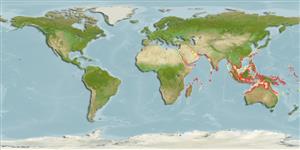>
Acanthuriformes (Surgeonfishes) >
Leiognathidae (Slimys, slipmouths, or ponyfishes) > Gazzinae
Etymology: Karalla: Karalla is the local name for ponyfishes in Sri Lanka and the surrounding region where members of this genus commonly occur.
More on author: Cuvier.
Environment: milieu / climate zone / depth range / distribution range
Ecologie
marien demersaal; diepte 1 - 40 m (Ref. 3424). Tropical
Indo-West Pacific: Gulf of Aden, along the coasts of India and Sri Lanka; including Pakistan, eastwards to the Philippines (Ref. 4537); probably not reaching Australia.
Grootte / Gewicht / Leeftijd
Maturity: Lm ? range ? - ? cm
Max length : 14.0 cm TL mannelijk / geslacht onbekend; (Ref. 3424); common length : 9.0 cm TL mannelijk / geslacht onbekend; (Ref. 3424)
Dorsale stekels (totaal) : 8; Dorsale zachte stralen (totaal) : 16; Anale stekels: 3; Anale zachte stralen: 14 - 15.
Found in shallow waters, predominantly over muddy bottoms (Ref. 30573). Usually occurs in schools. Feeds on polychaetes, bivalves, small crustaceans and sponges (Ref. 30573).
Levenscyclus en paargedrag
Maturiteit | Voortplanting | Paaien | Eieren | Fecunditeit | Larven
James, P.S.B.R., 1984. Leiognathidae. In W. Fischer and G. Bianchi (eds.) FAO species identification sheets for fishery purposes. Western Indian Ocean (Fishing Area 51). Vol. 2. FAO, Rome. pag. var. (Ref. 3424)
Status op de Rode Lijst van het IUCN (Ref. 130435: Version 2024-1)
Gevaar voor de mens
Harmless
Gebruik door de mens
Visserij: commercieel
Tools
Speciale rapporten
Download XML
Internetbronnen
Estimates based on models
Preferred temperature (Ref.
123201): 25.3 - 29.2, mean 28.3 °C (based on 1130 cells).
Fylogenetische diversiteitsindex (Ref.
82804): PD
50 = 0.7500 [Uniqueness, from 0.5 = low to 2.0 = high].
Bayesian length-weight: a=0.02512 (0.01311 - 0.04811), b=3.00 (2.84 - 3.16), in cm total length, based on LWR estimates for this species & (Sub)family-body (Ref.
93245).
Trofisch niveau (Ref.
69278): 3.0 ±0.36 se; based on food items.
Generation time: 0.9 ( na - na) years. Estimated as median ln(3)/K based on 2
growth studies.
Weerstandsvermogen (Ref.
120179): Hoog, minimale populatieverdubbelingstijd minder dan 15 maanden (Preliminary K or Fecundity.).
Fishing Vulnerability (Ref.
59153): Low vulnerability (11 of 100).
